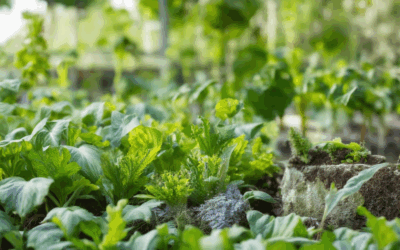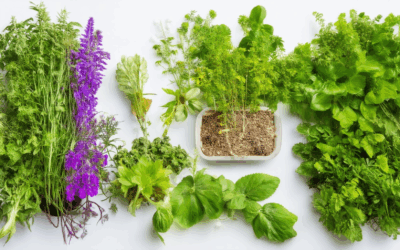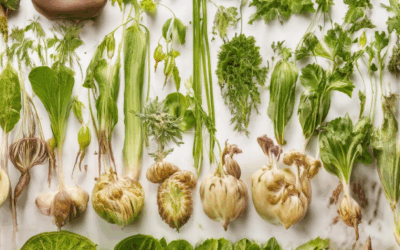Seasonal crop planning is a cornerstone of successful farming, offering a structured approach to optimizing yields and ensuring sustainable productivity. By thoughtfully considering rotations, cycles, and growth patterns, farmers can adapt to the unique challenges of each growing season. This comprehensive guide delves into the intricacies of seasonal crop planning, exploring how rotations and cycles can enhance soil health, reduce pest pressures, and maximize crop diversity. Whether you’re new to seasonal farming or looking to refine your existing practices, this guide provides valuable insights and practical strategies to create a robust crop plan tailored to your farm’s needs. From selecting the right cover crops to navigating the seasonal farming cycle, we’ll walk through everything you need to know to master seasonal crop planning and achieve optimal growth.
Key Takeaways
– Seasonal Cover Crops Enhance Soil Health: Implementing cover crops like annual ryegrass, oilseed radish, and sweet clover improves soil fertility, suppresses weeds, and promotes nitrogen fixation.
– Fast-Growing Cover Crops for Quick Results: Choose buckwheat, berseem clover, or oats for rapid growth and effective erosion control.
– Plan Cover Crops Strategically: Select varieties suited to your climate, plant seeds in late summer or early fall, and mix species for better adaptability.
– Understand Seasonal Cropping Systems: The Indian Kharif (July–October) and Rabi (October–March) seasons support diverse crop rotations, reducing pest issues and enhancing biodiversity.
– Leverage Seasonal Benefits: Aligning with natural rainfall patterns improves soil health, conserves water, and supports sustainable farming practices.
– Explore Resources for Success: Visit Old Seed for heirloom seeds and tailored cover crop solutions.
Seasonal Crop Rotation Example
A seasonal crop rotation is a farming practice where different crops are planted in sequence to maintain soil fertility, reduce pest populations, and optimize yield. One common example of a three-year rotation involves planting legumes (like beans), followed by vegetables (such as tomatoes, peppers, and eggplants), and then grains or staple crops (like corn or wheat). This cycle allows the soil to recover and replenish nutrients lost during each growing season.
Examples of Seasonal Crop Rotations:
- Three-Year Rotation:
- Year 1: Legumes (e.g., soybeans, alfalfa, or clover)
- Year 2: Vegetables (e.g., tomatoes, peppers, cucumbers)
- Year 3: Grains (e.g., corn, wheat, or oats)
- Two-Year Rotation:
- Year 1: Crops like potatoes and onions
- Year 2: Corn or soybeans
- Four-Year Rotation:
- Year 1: Wheat
- Year 2: Barley
- Year 3: Oats
- Year 4: Rye or Triticale
Each rotation has its benefits, but the choice often depends on local climate, soil conditions, and the specific crops being grown.
Benefits of Crop Rotation:
- Improved Soil Health: Different crops absorb various nutrients, enriching the soil for future crops.
- Reduced Pest Populations: Planting diverse crops confuses pests, leading to lower infestation levels.
- Disease Resistance: Crops in a rotation are less likely to suffer from diseases prevalent in monocropping systems.
Considerations for Effective Rotation:
- Climate and Soil Type: Some rotations work better in warmer climates, while others thrive in cooler regions.
- Companion Planting: Certain crops complement each other well, enhancing biodiversity and nutrient exchange.
- Market Demand: Farmers may choose rotations based on what is most profitable or in demand.
By implementing effective seasonal crop rotations, farmers can achieve more productive and sustainable farming operations.
The Seasonal Farming Cycle Explained
The seasonal farming cycle is a crucial pattern that dictates the growth, maintenance, and harvest of crops throughout the year. This cyclical approach ensures productivity, sustainability, and adaptability to varying weather conditions. Below is a detailed breakdown of the typical seasonal farming cycle:
Spring
- Preparation : Farmers begin by preparing the soil, removing weeds, and testing the pH levels to ensure optimal growth conditions.
- Planting : Seeds are sown in early spring, typically in rows to maximize space and sunlight exposure.
- Variety Selection : Farmers choose crop varieties suited for the local climate, soil type, and growing season.
Summer
- Growth : Crops grow rapidly during summer months, requiring regular watering, fertilization, and pest control measures.
- Maintenance : Weeds and invasive plants are managed to compete with the main crop for nutrients and sunlight.
- Support Systems : Stakes, trellises, or supports are installed to help plants reach full height and produce healthy fruit or vegetables.
Autumn
- Harvesting : The primary crop is ready for harvest when fruits, vegetables, or grains reach their mature state, ensuring maximum yield and quality.
- Post-Harvest Care : Fields are plowed or left fallow to prepare for the next planting season, allowing organic matter to decompose and enrich the soil.
Winter
- Rest Period : During winter, fields often lie fallow to allow the soil to recover and replenish nutrients lost during the previous growing season.
- Planning : Farmers use this time to plan next season’s planting schedules, rotate crops to prevent soil depletion, and adjust farming practices based on past successes and challenges.
The Importance of the Cycle
This seasonal cycle ensures biodiversity, soil health, and long-term agricultural productivity. By aligning with nature’s patterns, farmers reduce reliance on synthetic inputs and promote ecological balance. This method also enhances resilience against extreme weather events and market fluctuations.
For further reading on traditional farming methods and sustainable practices, explore Old Seed’s Heirloom Gardening Guide and learn how to integrate these cycles into your own garden. Additionally, discover tips for Sustainable Farming Practices to support your agricultural endeavors.
How to Create a Crop Plan
To create an effective crop plan, follow these organized steps tailored for your moderate climate zone:
1. Identify Suitable Crops
Choose crops that thrive in your USDA zone. Consider options like tomatoes, peppers, and beans, which are well-suited for your region. Research local varieties and seasonal availability to maximize productivity.
2. Prepare the Land
Till the soil in your backyard garden. Incorporate compost, such as last year’s garden compost or locally sourced farm compost, to enrich the soil. Test the soil pH; aim for a balance around 6.0-7.0 for optimal plant health, particularly for tomatoes.
3. Select Planting Methods
Decide whether to start seeds indoors or direct sow. Starting seeds indoors requires regular attention to lighting and watering. Transplants need proper hardening off before outdoor planting, typically involving a week or two of gradually increasing exposure to outdoor conditions.
Plant Spacing
Plan a grid or chart to ensure adequate spacing between plants, especially for crops like tomatoes that require room to grow. Proper spacing prevents overcrowding and reduces the risk of diseases.
4. Watering Strategy
Install an efficient irrigation system, such as drip irrigation, to manage water usage effectively. Apply mulch, like straw or wood chips, to conserve moisture and suppress weeds.
5. Pest and Weed Management
Implement integrated pest management techniques. Use companion planting, such as marigolds to deter pests, and monitor for weeds frequently. Consider natural herbicides if chemical treatments are avoided.
6. Fertilization Schedule
Fertilize at planting time and apply side-dressings mid-season. Use compost as a natural fertilizer and test soil nutrient levels periodically to adjust as needed.
7. Harvest Planning
Note the harvest times for each crop variety. Stagger planting to extend the harvest period, such as planting tomatoes in batches every two weeks.
8. Preservation Techniques
Preserve your harvest through methods like canning or pickling. Start with simple recipes and seek reliable guides for safe food preservation practices.
9. Record-Keeping
Maintain a gardening journal to document successes and challenges. Track plant varieties, care methods, and yields to refine your crop plan annually.
10. Enjoy the Process
Embrace the gardening experience. Each season presents unique challenges and rewards, fostering a connection with nature and providing fresh, homegrown produce.
By following these steps, you can create a tailored crop plan that maximizes your gardening efforts and enjoys the fruits of your labor.
Seasonal Cover Crops Explained
Cover crops are plants grown temporarily to improve soil health, prevent erosion, and provide environmental benefits. Seasonal cover crops are particularly effective during fall, winter, and spring, as they protect soil from temperature fluctuations and nutrient leaching.
These crops are often chosen for their ability to fix nitrogen in the soil, enhance soil organic matter, and suppress weeds. They also act as green manure, decomposing to release vital nutrients for subsequent crops.
Benefits of Seasonal Cover Crops
- Improves soil fertility and structure
- Reduces erosion and run-off
- Suppresses weeds and pests
- Provides habitat for pollinators and beneficial insects
- Helps manage waste materials like crop residues
Common Types of Seasonal Cover Crops
- Annual Ryegrass : A fast-growing grass used widely for cover cropping due to its ability to quickly establish root systems.
- Oilseed Radish : Known for its deep roots and ability to break up compacted soil, oilseed radish is a popular choice for heavy clay soils.
- Winter Cereal Rye : A cold-tolerant crop that grows well in cooler temperatures and provides erosion control during the winter months.
- Sweet Clover : A nitrogen-fixing legume that improves soil health and provides nectar for pollinators.
- White Clover : Similar to sweet clover, white clover is known for its drought tolerance and ability to fix nitrogen.
Planting Tips for Success
- Choose varieties suited for your climate and soil type.
- Plant seeds during the late summer or early fall for establishment before winter.
- Mix species for better coverage and adaptability to different soil conditions.
- Ensure proper drainage to prevent rotting roots in wet conditions.
- Consider using cover crop seed mixes tailored to specific purposes, such as nitrogen fixation or erosion control.
For more detailed information and resources on selecting and managing seasonal cover crops, visit Old Seed , your trusted source for heirloom gardening and sustainable agriculture solutions.
The Fastest Growing Cover Crops
When selecting cover crops, understanding their growth rates and benefits is crucial for maximizing their effectiveness. Here are some of the fastest-growing cover crops available:
- Buckwheat : Known for its rapid growth, buckwheat is an excellent choice for covering bare soil quickly. It grows best in cool weather and can be harvested for grain or left as a green manure.
- Berseem Clover : This nitrogen-fixing plant grows rapidly and is ideal for improving soil health. It’s commonly used in crop rotations to enhance fertility.
- Austrian Winter Pea : A winter cover crop that grows quickly and fixes nitrogen, making it perfect for areas where winter coverage is needed. It’s also known for its ability to suppress weeds.
- Annual Ryegrass : A fast-growing grass that provides erosion control and can be used as a temporary ground cover. It’s particularly useful in sloped areas.
- Oats : Oats grow rapidly and are often used as a cover crop to prevent soil erosion and improve organic matter. They can be grown in diverse conditions and are easily managed.
These cover crops are not only fast-growing but also offer various benefits, from improving soil health to suppressing weeds. For more information on selecting the best cover crops for your specific needs, visit our cover crops guide .
Explore our selection of best cover crops to find the perfect solution for your farm or garden.
Season-Based Crops
The Indian cropping system is divided into two primary seasons: Kharif and Rabi. These seasons are determined by the monsoon rains and play a crucial role in determining crop types and harvest timings.
Kharif Cropping Season
- Characteristics: Runs from July to October, coinciding with the southwest monsoon.
- Crops:
- Mangoes
- Paddy (rice)
- Sugarcane
- Groundnuts
- Gram (chickpeas)
Rabi Cropping Season
- Characteristics: Spans from October to March, typically during the winter months.
- Crops:
- Wheat
- Barley
- Mustard
- Peas
- Sorghum
Benefits of Seasonal Cropping
- Environmental Benefits: Aligns agricultural practices with natural rainfall patterns, promoting soil health and water conservation.
- Economic Benefits: Supports diverse crop rotations, reducing pest issues and enhancing biodiversity.
At Old Seed, we advocate for sustainable farming practices that respect these natural cycles. Our heirloom seeds are carefully selected to thrive in specific seasonal conditions, ensuring robust yields and nutritional quality.
Conclusion
Understanding and utilizing seasonal cropping patterns is essential for sustainable agriculture. By aligning with nature’s rhythms, farmers can maximize productivity while preserving ecosystems.








0 Comments